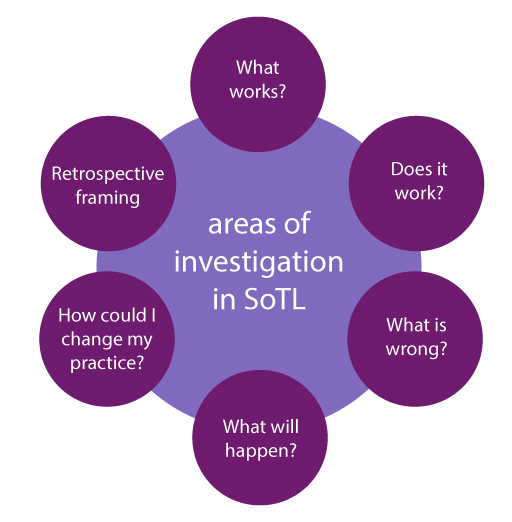3.2.1 Areas of investigation in SoTL
In this section, we extend Hutchings’ guidance and present a taxonomy of areas of investigation in SoTL that may help you to formulate the aim and research questions for a SoTL inquiry.
The six categories are: what works?; does it work?; what is wrong?; what will happen?; how could I change my practice?; and retrospective framing. We explain each of these categories with examples of SoTL inquiries in STEM (Figure 1).
What works? If a particular teaching method or approach is effective, you may like to investigate why it is working well and whether/how the lessons or good practice could strengthen your approach, and/or be transferred to other contexts within your discipline and in other disciplines.
Example: Based on the positive student feedback of live fieldcasts to support students who couldn’t attend outdoor field trips, a group of colleagues in Environmental Sciences at the OU are investigating how interactive live fieldcasts can be used to support, enhance and widen access to authentic fieldwork experiences.
From the outcomes of the SoTL inquiry, colleagues are aiming to improve their practice of live fieldcasting and to better understand how this technology can be deployed in other contexts within OU and beyond.
Does it work? When you introduce an intervention, you may like to evaluate its effectiveness – how it has influenced student learning and engagement and whether/how it has met the intended learning outcomes.
Example: A module team introduced a blog in an outdoor fieldwork component of a biology module. The SoTL inquiry related to whether the blog had been effective for the purpose that was intended: a blog will be useful for recording and sharing experiences, for preparing notes for assessment and as a revision-aid for the end-of-module examination.
What is wrong? A SoTL inquiry may involve investigating a ‘problem area’ to determine the causes and to derive recommendations for improvement. The problem area may have been highlighted through your own reflections, student feedback, marking of assessments, student performance data or learning analytics.
Example: A module team had designed a quiz as a formative assessment activity on a first-level computer science module. Based on experiences of another module, they knew that students who attempt the quiz perform better in summative assessment compared to those who don’t. However, in this first-level computer science module, the team found that only a small percentage of the students was engaging with the quiz. Further, attempting the quiz didn’t affect student performance in the summative assessment as compared to those who were not engaging with the quiz. The module team set up a SoTL inquiry to investigate whether it was the design of the quiz or its timing within the module that was influencing the use of the quiz and its effectiveness for student learning and engagement.
What will happen? This question relates to investigating innovations or novel interventions. In this situation, you or your colleagues may not have any related previous experience to draw out any firm conclusions on whether the intervention will work or not. Also, there may be no evidence in the literature on the effectiveness of the proposed intervention in your context.
Example: A colleague in the department of Mathematics at the OU investigated whether an early start (three months before the actual start) through a dedicated website and ongoing tutor support on the Introducing Statistics module would help in student retention on this module and on concurrent modules.
Critically reflecting on your academic practice will be integral to every SoTL inquiry in this taxonomy. But you may conduct a SoTL inquiry specifically to investigate your own practice. So, another category in this taxonomy is:
How could I change my practice? You may like to reflect on your own practice/module to determine any changes/improvements that could be made to improve student learning and student experience. Based on student feedback, or your own observations in a tutorial or lecture theatre, you may be able to pick up aspects that you would like to reflect on in a SoTL inquiry.
Example: A colleague in the Design department moved from a theory-driven module to relating case studies and integrating interviews of subject experts from real-world practice in her module’s delivery. She conducted a SoTL inquiry to investigate how effective she had been in linking up the classroom delivery with industry practice. Her inquiry involved collecting feedback from students on whether her efforts had contributed towards them getting offers for internship, and whether the materials she used facilitated easy induction into industry practice.
Retrospective framing: This category of SoTL inquiry relates to consolidating empirical work from previous SoTL inquiries or projects that may have incrementally developed into a theory, model or a framework aimed at enhancing academic practice and improving student experience.
Example: At the OU, an online STEM Lab called The OpenSTEM Labs [Tip: hold Ctrl and click a link to open it in a new tab. (Hide tip)] (OSL) delivers authentic practical experiences to distance learning students in STEM subjects. It employs realtime instrumentation, data and equipment for conducting practical enquiries over the internet. The OSL has received substantial investment over the years to build a large repository of experiments.
A group of colleagues are investigating the breadth of learning outcomes developed across all the OSL experiments thus far with a view to build a taxonomy of remote/onscreen laboratory activities, learning outcomes and assessments.
The searchable taxonomy will benefit STEM colleagues to find information about existing OSL experiments for possible reuse. The project will benefit students by enhancing the use of the OpenSTEM Labs in OU’s STEM learning and teaching.
The categories in this taxonomy of areas of investigation in SoTL (Figure 1) are not mutually independent. You may include the characteristics of more than one category in your inquiry. When you are developing the research questions for the aim of your inquiry, you may like to reconsider the aim and iteratively refine the aim and research questions, if necessary.
Activity 5 Aim and research questions
For your SoTL inquiry, describe the aim and one or more research questions.
If you are not currently planning to conduct a SoTL inquiry, describe which categories of research questions described in this section most resonate with any other research project that you would like to conduct or get involved with.

